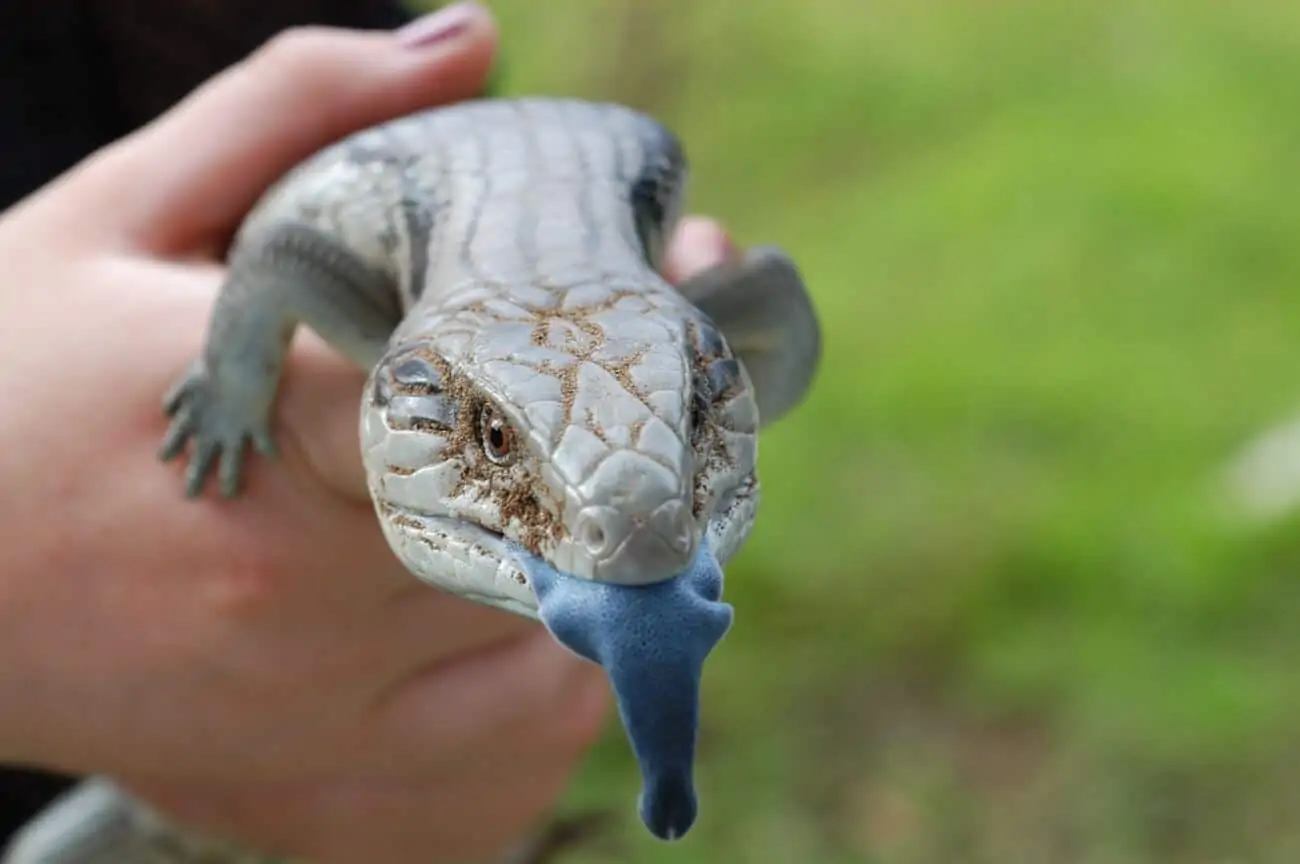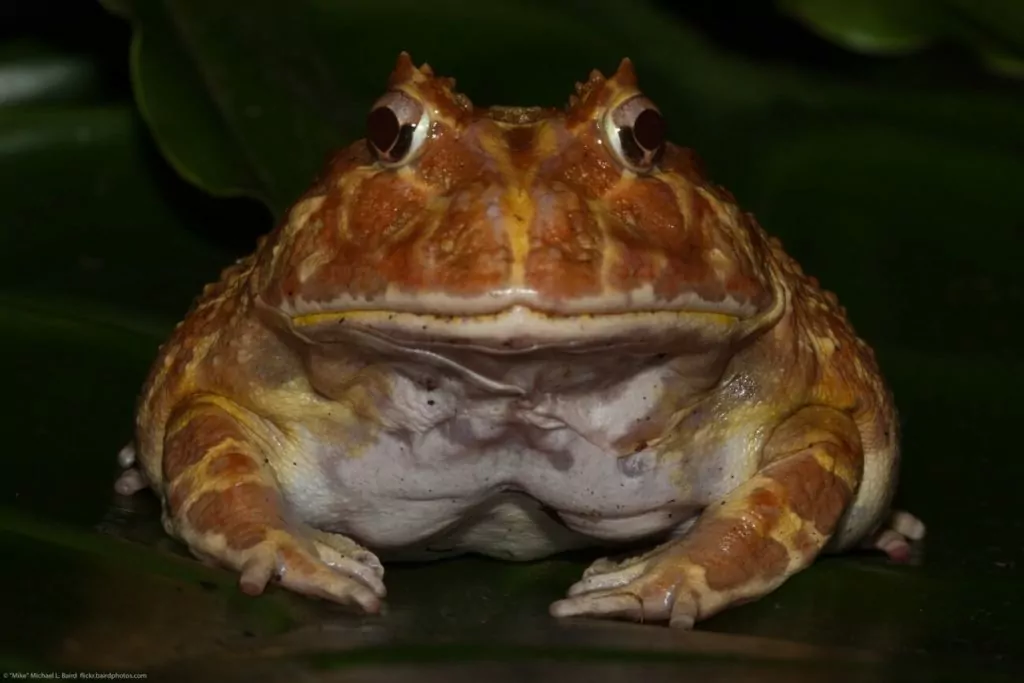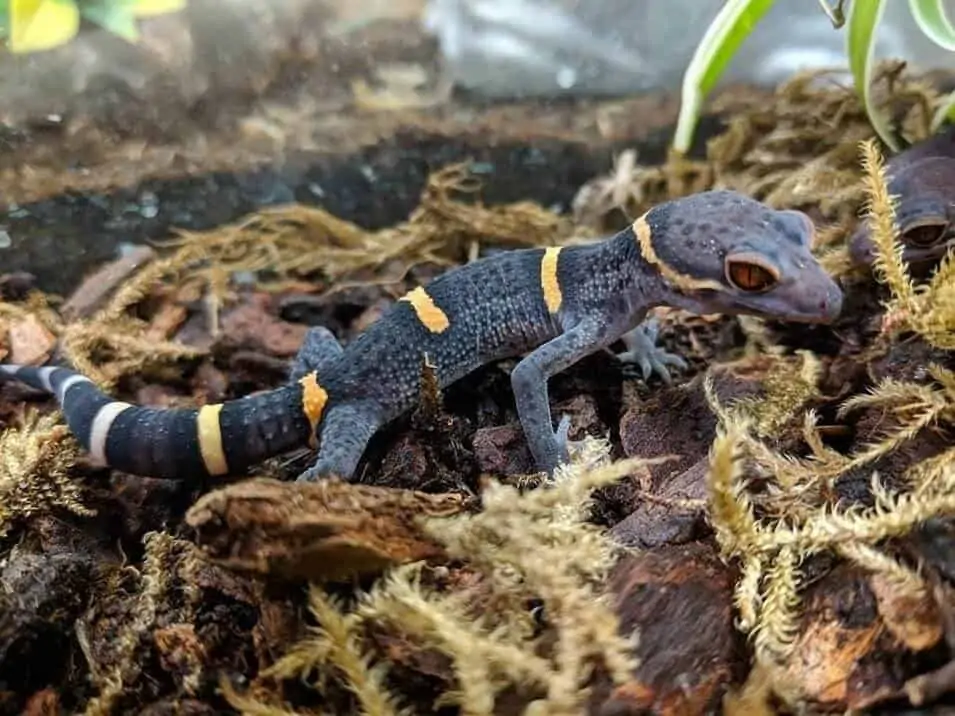Blue tongue skinks are a fascinating reptile that has become quite a popular pet in recent years.
And it’s obvious why.
These lizards are unique, docile, and easy to care for. They’re honestly one of our favorites!
But just like any reptile, this species has some fairly strict dietary and environmental needs. And any owner that’s interested in one needs to know what they are!
So that’s why we made this guide. In it, you’ll learn everything you need to know about blue tongue skink care so you can help your pet live a happy and healthy life!
Table of Contents
Species Summary
Aptly named for their vibrant blue mouths, the blue tongue skink (Tiliqua scincoides) is a favorite among reptile enthusiasts. These lizards originally come from Australia, Indonesia, and Papua New Guinea. But today, they are bred across the globe.
Several subspecies are considered to be part of the larger blue tongue skink family. They all have that iconic blue tongue and a relatively similar shape.
However, there are noticeable regional differences.
The variation within the species has put the blue tongue skink in a very unique position. On one hand, it’s considered a good pet for novice reptile owners. That said, seasoned lizard keepers love this species as well because of the many rare subspecies available.
The most common variant you’ll see in the reptile trade is the Northern blue tongue skink. It’s an easy-going reptile that adapts well to many environments.
Not only that, but it’s one of the few reptile species that actually enjoy being handled!
Lifespan
The average blue tongue skink lifespan is somewhere between 15 and 20 years. However, these reptiles can live longer.
There have been reports of specimens making it well past the 20-year mark! However, those lizards are more of an exception rather than the rule.
Like any other captive reptile, a blue tongue skink’s health is directly affected by the level of care you provide. A poorly maintained habitat and a lackluster diet will lead to stress, disease, and a shorter lifespan.
Appearance & Colors
While it’s technically considered to be a lizard, blue tongue skinks are a class of their own. They have an unmistakable shape that’s very different from what you’d see with other lizard species in the trade.
Blue tongue skinks are large and heavy. These creatures are covered in scales and have a smooth shape that closely resembles a snake. In fact, it’s easy to mistake skinks for snakes when they are buried or partially hidden!
The legs of these amazing lizards are small, too. They’re quite stubby and easily tuck under the body.
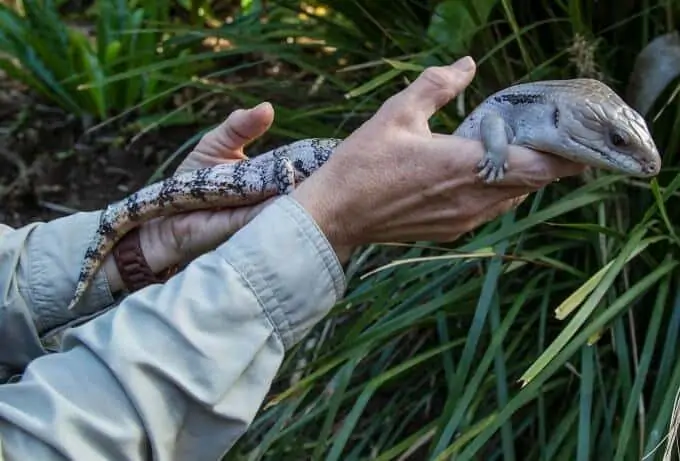
The head of the blue tongue skink is large and triangular. These animals have very strong jaws. Depending on the particular subspecies, they may also have large red or yellow eyes.
Of course, we can’t forget about the blue mouths! True to their name, the blue tongue skink has an eye-catching blue mouth and tongue.
Oftentimes, the lizard will use it to ward off potential predators. You might even see it if you accidentally do something to make them make uncomfortable!
As for color, there’s a bit of variation between subspecies. The popular Northern blue tongue skink has a light brown base color. Hues of orange, chestnut, and even red can be found throughout the back.
Other variants have distinct color morphs. You might see specimens that have dark brown and black stripes, those with light-colored skin, and those with large spots.
Average Size
The average blue tongue skink size is pretty big compared to other popular lizard species in the reptile trade. However, the exact size you can expect is going to depend entirely on the subspecies you choose.
The Northern blue tongue skink is one of the largest available. Adults reach lengths between 18 and 24 inches.
On the smaller end of the size spectrum, some subspecies only get to be about 12 inches long.
Expert Tip: Most are going to be on the larger end, so it’s best to plan accordingly and make sure that you have plenty of space.
Blue Tongue Skink Care
Like any other reptile, blue tongue skink care requires you to follow some rather strict guidelines if you want your pet to live a long and happy life.
These animals live in distinct habitats in the wild that cater to their biological needs and lifestyle. When you’re keeping one in captivity, your goal should always be to replicate their environment and provide a biologically appropriate diet.
While this might sound daunting, blue tongue skink is actually pretty simple (especially compared to a lot of other species). Their needs are relatively easy to manage and they don’t require any intense husbandry.
Enclosure Size
When you’re choosing an enclosure, it’s important to consider how these animals act in the wild. Blue tongue skinks are largely terrestrial which means they don’t spend too much time climbing in the trees.
This means floor space should be your top priority!
Adult blue tongue skinks can live very healthy lives in a tank size of 40 or 50-gallon. As a bare minimum, the enclosure should measure at least 36 inches long, 18 inches wide, and 10 inches tall.
If you have the space in your home to go larger, aim for an enclosure that’s closer to 48 inches long, 24 inches wide, and 24 inches tall.
The best type of enclosure for a blue tongue skink is a glass reptile tank with a screened lid. The screened lid will promote ventilation, which helps to manage humidity levels a bit.
Expert Tip: You can also choose a reptile enclosure with swinging front doors. This design makes it easy to handle your reptile and gain access to the interior.
Habitat Setup
Planning the perfect habitat for a blue tongue skink is much easier than most people think!
With other lizard species, you have to choose the perfect decorations and plants. But with the blue tongue skink, that’s not the case.
Remember, these reptiles prefer floor space over anything else. This means it’s best to keep the habitat relatively bare. Too many decorations will only make the skink uncomfortable. In most cases, they’ll just end up rearranging things anyways!
Because you’re not going to be using a ton of decorations, you’ll need to pay closer attention to the essentials.
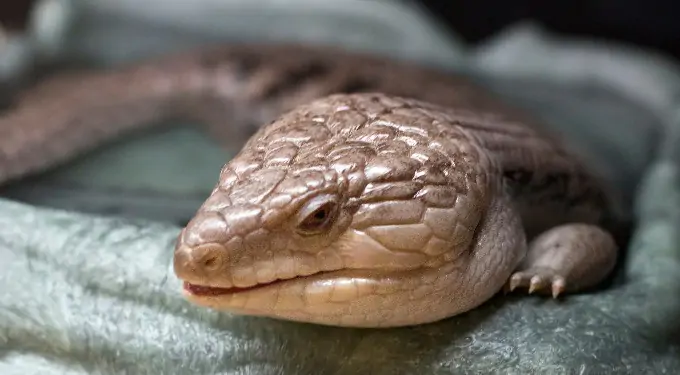
Starting with the substrate, use a dry, semi-soft material. Something like aspen, cypress mulch, recycled paper, or even a peat moss/sand mixture.
Avoid using anything too hard. Blue tongue skinks may try to eat the substrate, which could lead to impaction issues. The same goes for potentially toxic substrate materials like cedar chips or cat litter!
Blue tongue skinks aren’t huge climbers, but they do enjoy basking on a raised rock every once in a while. Incorporate a few rocks and logs into the habitat, but don’t go overboard! Remember, crawling floor space is the most important thing.
You may also want to add a hide box. You can make one yourself out of wood or purchase a premade box that’s crafted out of plastic.
Either way, this box should be big enough for the lizard to get into when they’re feeling a bit overwhelmed.
Temperature & Lighting
Blue tongue skinks self regulate their body heat. As a result, you’re going to have to create a gradient temperature arrangement in the enclosure.
That means that one side of the tank/cage will be hotter than the other.
Over on the cool end, temperatures should be between 75 and 85 degrees Fahrenheit. At night, temperatures can dip to the low 70s.
Expert Tip: You must ensure that ambient temperatures do not get lower than that! If they do, you’ll need to invest in a heating pad or ceramic emitter to keep temperatures stable.
On the opposite side of the enclosure, you can create a basking area. This will be a heated part of the habitat that the lizard will use to increase their body temperature when they feel cold.
Using a heat emitter or overhead incandescent light, heat one spot of the enclosure to temperatures between 90 and 100 degrees Fahrenheit. This basking area should be on for about 12 hours a day.
In addition to standard lighting, blue tongue skinks will also need UVB lighting. UVB lighting is meant to replicate the effects of the sun’s rays, which are crucial for good health. When kept indoors, many reptiles that don’t have exposure to UVB rays develop bone diseases.
Those UVB rays are necessary for metabolizing calcium. You can install a UVB light over the enclosure and leave it on for 12 to 14 hours per day. You won’t be able to see the UVB light, so make sure that you’re changing out the bulb every 6 months for good measure.
Humidity
In the wild, blue tongue skinks live in semi-dry environments. They need some humidity, but not too much of it.
Ideally, levels of 40 to 60 percent are just fine.
Purchase a hygrometer and use it regularly to stay on top of humidity levels. Too much humidity can cause respiratory infections and skin issues.
The lights you use should be enough to decrease humidity. If you need to increase levels, just mist the enclosure once a day.
Water
You’re not going to see blue tongue skinks drinking very often. They stay hydrated a bit differently than other animals.
Still, providing a large water dish is essential. The dish should be large enough for the skink to soak in!
You might see your lizard crawling into the dish and laying motionless for a bit while they rehydrate. This is perfectly normal.
Expert Tip: Use a solid dish that can’t be tipped over. Also, keep an eye on this dish and refill it frequently.
Blue Tongue Skink Diet & Food
Blue tongue skinks are omnivores. They have pretty healthy appetites and aren’t particularly picky about the things they consume. This means they will readily accept most foods without any issues.
Variety is very important when it comes to the diet of a blue tongue skink.
Owners will typically mix up food ingredients regularly to ensure that the lizard is getting all the nutrients and vitamins they need. Some will even plan out meals ahead of time and break down the nutrient profile for better control.
As a good rule of thumb, 40 percent of their diet should consist of protein-based foods.
The remaining 60 percent needs to be plant-based foods. Approximately 50 percent should be vegetables while 10 percent should be sweet fruits.
There’s a lot that you can feed blue tongue skinks. Here are some good options for proteins:
- Mealworms
- Crickets
- Thawed frozen mice
- Boiled chicken
- High-quality canned dog or cat food
- Ground turkey
Here are some fruits and vegetables you can try in their diet as well:
- Spring greens
- Collard greens
- Spinach
- Dandelion
- Carrots
- Raspberries
- Peas
- Figs
- Mango
Adult blue tongue skinks will need to be fed every two or three days. Younger lizards may need more frequent feedings every other day.
Potential Health Issues
You’ll be happy to know that blue tongue skinks aren’t susceptible to any major illnesses that are specific to the species. However, there are some common reptile diseases that you need to keep an eye out for.
The first is metabolic bone disease. This occurs when your reptile isn’t getting that UVB exposure they need. They may develop bone deformities, fractures, and more.
To avoid this, make sure that you’re providing those 12 to 14 hours of UVB exposure per day. You can also dust food with calcium powder for good measure.
Respiratory infections and skin issues are common, too. More often than not, these problems are directly caused by high humidity levels in the enclosure. Check the humidity levels and open up the top of the tank to let some of that humid air out!
Behavior & Temperament
It’s best to keep blue tongue skinks in solitary tanks. These animals are known to show some aggression towards other creatures. They will even fight among those of the same species.
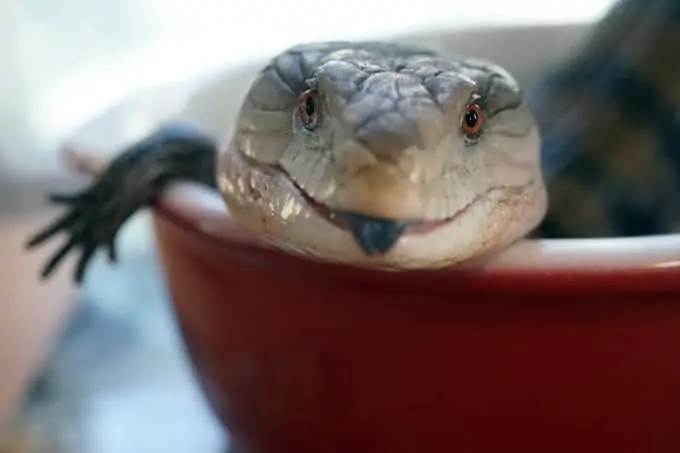
It may be possible to keep two females together or a bonded male and female pair. However, two males should never be kept together!
Handling Them
Overall, blue tongue skinks are quite docile with humans. They have a reputation for being one of the most personable reptile species around.
Some skinks will even show signs that they enjoy head rubs!
Of course, you should always exercise caution before handling reptiles. Blue tongue skinks are no different. When they feel anxious, these lizards will hiss and flash their blue mouths. They are perfectly capable of biting, so you should never handle them forcefully.
Give the lizard some time to acclimate to its new environment. Once they get more comfortable in the enclosure, you can start handling them.
Start by holding them for short 10-minute sessions. Do this close to the carpet or something soft just in case you drop it! Support the skink’s entire body when you hold it. This will help it feel safe and secure.
The more you handle the blue tongue skink, the more it will get comfortable with the process. If you do things right, you may get to the point where the lizard wants you to hold them!
Wrapping Up
By now, you probably understand why we’re such a big fan of this species. Not only do they have a very interesting look, but they’re super low-maintenance!
In fact, we consider blue tongue skink care to be something anyone can manage (no matter how much experience they have). As long as you follow the care guidelines we listed in the sheet above, you’ll be all set!
If you have any other questions about how to take care of this reptile, don’t hesitate to reach out. We know a care guide can’t cover everything!

